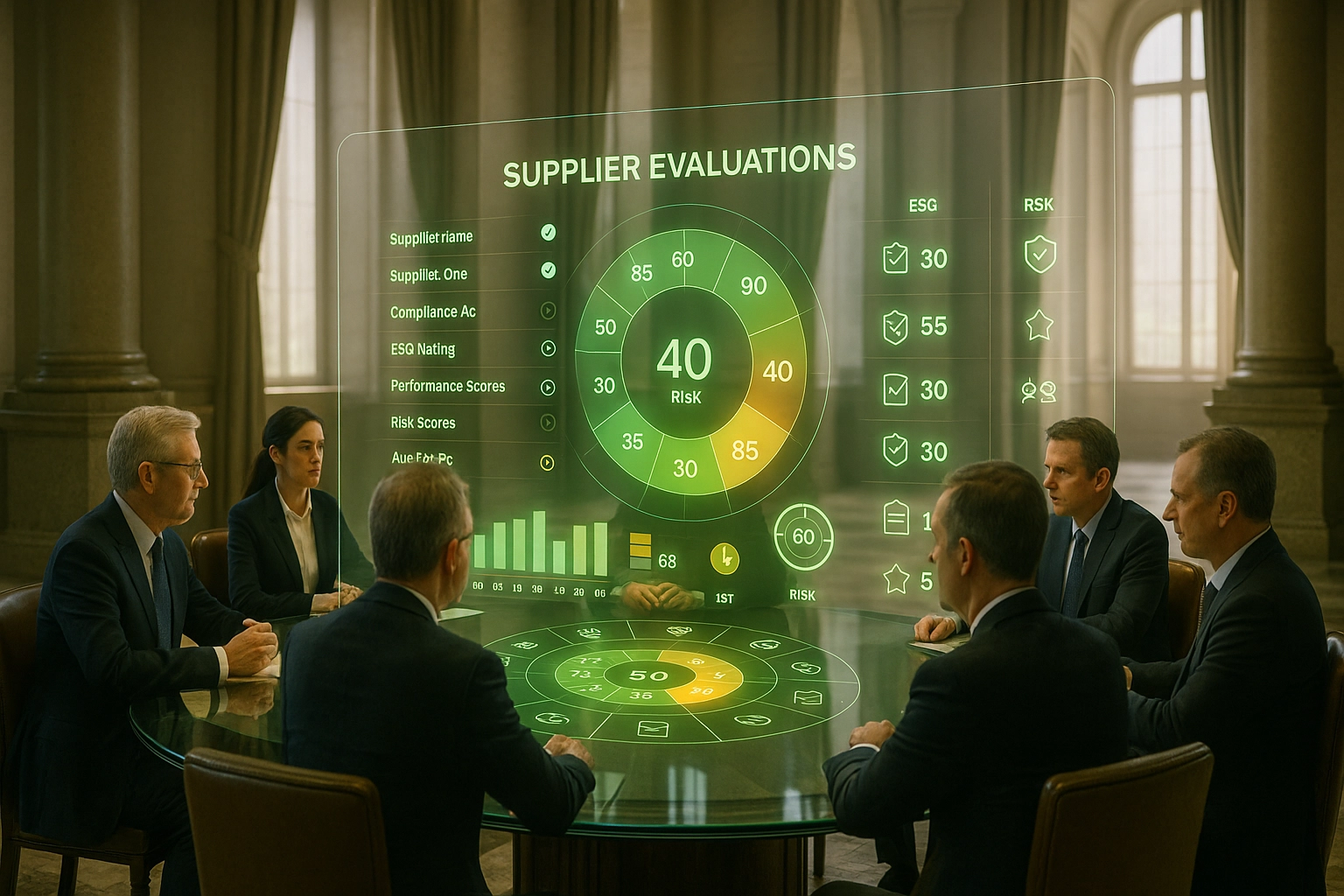ESG and Supply Chain: Emerging Challenges for 2025

La transformation ESG révolutionne la supply chain en 2025, devenant un impératif stratégique pour toute entreprise moderne. La directive CSRD, entrée en vigueur depuis janvier 2024, impose aux entreprises européennes une transparence totale sur leurs impacts environnementaux et sociétaux. Cette évolution réglementaire majeure s’accompagne de nouvelles exigences comme le CBAM (Carbon Border Adjustment Mechanism) et la Deforestation Regulation qui renforcent encore la nécessité d’une gouvernance rigoureuse des tiers. Les grandes entreprises devront démontrer leur impact sur les peThe ESG transformation is revolutionizing the supply chain in 2025, becoming a strategic imperative for every modern business. The CSRD directive, in effect since January 2024, now requires European companies to ensure full transparency regarding their environmental and social impacts. This major regulatory shift affects all large businesses, which must disclose their effects on people and the environment, with first reports due in 2025.
What is ESG and Why Does It Matter for the Supply Chain?
ESG is now the global standard for assessing corporate sustainability. In the context of the supply chain, these criteria are now a legal requirement under the CSRD directive enforced since January 2024. The three core pillars—environmental, social, and governance—shape all reporting and compliance requirements:
- Environment: carbon footprint, energy usage, waste management, use of natural resources.
- Social: working conditions, human rights, local community contribution.
- Governance: management practices, transparency, business ethics.
In supply chains, incorporating ESG criteria means optimizing every stage of the procurement process to reduce environmental, social, and governance impacts. This applies to both internal operations and more importantly, to partner suppliers, especially under Scope 3 emissions.
ESG Transformation and Its Benefits
The ESG acronym is increasingly prevalent in supply chain discussions. With new regulatory demands approaching in 2025, companies must integrate these principles into their daily operations.
Necessary Transformation
By 2025, new regulations will mandate higher ESG standards. To remain competitive, companies must invest in more responsible sourcing practices and improve supply chain traceability. Failing to adapt may lead to penalties and reputational damage.
Strategic Advantages
Adopting ESG criteria in the supply chain brings measurable and strategic benefits. Companies with a mature ESG approach have reduced operational costs by 15% to 25% via resource optimization. ESG also boosts operational resilience to climate risks and significantly enhances customer satisfaction, with a 35% increase in loyalty for sustainable brands.
Leveraging Regulatory Momentum
New ESG compliance requirements are reshaping the retail and industrial sectors in 2025. Multi-site compliance and document traceability are now strategic priorities for any complex supply chain. Companies must demonstrate control over their critical suppliers and associated environmental risks.
Proactive Strategy and Flexibility
To meet future demands, companies must adopt a proactive approach now. This includes conducting audits, training employees, and assessing supplier ESG maturity. Early risk identification enables strategic adjustments and avoids reactive sourcing decisions.
Leadership and Positive Influence
ESG pioneers become industry benchmarks. By investing in innovation, they prove their commitment extends beyond regulatory compliance and inspire sector-wide improvements.
Setting and Reaching ESG Goals
Clear and realistic ESG objectives are vital for any ambitious supply chain. Start with a comprehensive risk assessment to pinpoint improvement areas. ESG risk mapping is a key component of this process.
Action Prioritization
Not all businesses have the same resources. Prioritize actions based on impact and cost. A focused action plan avoids waste and maximizes results. Companies are encouraged to identify key UN Sustainable Development Goals (SDGs) with a supply chain lens.
Monitoring and Continuous Improvement
Once the objectives are defined, it is essential to implement specific performance indicators through dynamic dashboards. These will make it possible to measure progress, particularly among suppliers, and adjust strategies as needed. Ongoing monitoring and regular reviews ensure the long-term sustainability of the improvements made.
Key ESG metrics include:
| Type of Indicator | Examples | Benefits |
|---|---|---|
| Compliance Indicators | ESG audit coverage rate, percentage of certified suppliers | Immediate visibility into ESG maturity level |
| Progress Indicators | Evolution of suppliers’ ESG scores, adoption rate of best practices | Measurement of corrective action effectiveness |
| Impact Indicators | Actual reduction in Scope 3 emissions, improvement in working conditions | Tangible demonstration of results for CSRD reporting |
Assess Your ESG Maturity Today
Want to understand where your company stands in its ESG journey and identify your top improvement areas? Our experts can help you build a personalized diagnosis of your supply chain.
Embedding ESG into Daily Operations
Incorporating ESG into the supply chain requires a sector-specific approach. For retail, priorities include managing complex global supply chains and ensuring multi-site compliance. In industry, it’s about managing critical suppliers and environmental risk. All sectors must address their extended ecosystem.
Internal Training and Engagement
ESG compliance becomes a strategic priority in 2025, as the CSRD comes into force for all large European businesses. This transformation requires broad internal alignment across three main axes:
- Standardized reporting: align with ESRS to ensure transparency.
- Value chain focus: up to 80% of environmental impact comes from suppliers, requiring accurate data collection.
- Continuous education: awareness programs to embed ESG in everyday work.
Strategic Partnerships
Collaborating closely with suppliers and other stakeholders is essential. By sharing the same commitments and working together, it becomes easier to adopt smart and effective solutions. These partnerships also allow for pooled efforts and a broader positive impact across the entire supply chain — as demonstrated by TAG Heuer.
Sector-Specific ESG Considerations
These sector-based approaches translate into concrete actions:
In retail, leading brands now systematically integrate ESG assessments for their international suppliers, reducing non-compliance risks in their supply chains by 35%, according to Sedex data (2025). Comprehensive document traceability is becoming the standard to ensure multi-site compliance.
In the industrial sector, ICPE (Classified Installations for Environmental Protection) sites are implementing continuous monitoring systems for their critical supply chains. This allows them to anticipate environmental risks and maintain proactive compliance.
In the construction sector, subcontractor certification based on strict ESG criteria has led to a 25% reduction in environmental incidents on construction sites, according to the Veriforce CHAS study (2024), while also improving overall regulatory compliance. To dive deeper, read our article on decarbonization strategies in the construction sector.
Optimizing Operations for Lower Footprint
Operational optimization is key to reducing the supply chain’s ecological footprint, from production to final delivery.
Technology and Innovation
TPGRC solutions (Third Party Governance and Risk Compliance) revolutionize ESG supply chain management. They offer:
- Dynamic risk mapping with continuous supplier assessments.
- Full document traceability for regulatory compliance.
- Shared ESG data to simplify supply chain monitoring.
- Automated workflows for environmental performance tracking.
Circular Economy
Embracing the circular economy is another effective method. Instead of simple recycling, this model preserves value by keeping materials in use. Reuse, remanufacturing, and recycling gain new relevance in lowering environmental impact.
Responsible Sourcing and Supplier Selection
Choosing the right suppliers is essential for ESG-aligned supply chains. Responsible sourcing involves partnering with businesses that share your values.
Strict Selection Criteria
Establish clear criteria for selecting suppliers, including recognized environmental certifications, human rights policies, and fair labor practices.
Audits and Support Programs
Regular audits help ensure supplier compliance. Offering support strengthens partnerships and promotes continuous improvement. The goal is to build a network of partners committed to responsible practices.
Integrating ESG criteria into the supply chain in 2025 represents a major strategic transformation. Companies that successfully complete their ESG transition demonstrate:
- A significant reduction in operational risks through improved traceability and transparency
- Proactive compliance with the CSRD directive and upcoming European regulations (NIS 2, DORA)
- Cost optimization through the adoption of sustainable practices and circular economy models
- A measurable competitive advantage in markets sensitive to ESG issues
This evolution requires a collaborative approach among all stakeholders to build a more resilient supply chain. Today, TPRM platforms provide the necessary tools to turn this regulatory obligation into a strategic opportunity—reducing supplier administrative burden while ensuring optimal compliance.
How Aprovall Can Help
- Comprehensive supply chain audit: Assess ESG maturity across all suppliers—Tier 1 and beyond → Request a demo
- Industry-specific TPGRC solutions: Benefit from tailored ESG platforms → Explore our solutions
- Regulatory support: Get ready for CSRD 2025 with expert guidance → Contact an expert
🔍 Evaluate your ESG maturity for free and receive a personalized assessment.
These articles might interest you
-
 15 April 2025Supplier Evaluation in the Public Sector: A Strategic Governance ChallengeSecteurThe public sector accounts for a significant portion of economic activity in France and involves a large number of contract holders. As such, public sector actors face critical challenges in managing supplier relationships—especially since third-party qualification has become a cornerstone of public procurement strategies. Beyond basic oversight, it now forms part of a broader approach […]
15 April 2025Supplier Evaluation in the Public Sector: A Strategic Governance ChallengeSecteurThe public sector accounts for a significant portion of economic activity in France and involves a large number of contract holders. As such, public sector actors face critical challenges in managing supplier relationships—especially since third-party qualification has become a cornerstone of public procurement strategies. Beyond basic oversight, it now forms part of a broader approach […]Read more
-
 18 May 2025Multi-Entity TPRM Deployment for Large Groups: Strategy and ChallengesSecteurIn a context where large groups are orchestrating increasingly vast ecosystems of third parties, multi-entity deployment of TPRM has become a major strategic imperative. Société Générale exemplifies this reality with 119,000 employees across 62 countries, highlighting the operational complexity of modern multi-site structures. This exponential complexity calls for third-party governance adapted to the challenges of […]
18 May 2025Multi-Entity TPRM Deployment for Large Groups: Strategy and ChallengesSecteurIn a context where large groups are orchestrating increasingly vast ecosystems of third parties, multi-entity deployment of TPRM has become a major strategic imperative. Société Générale exemplifies this reality with 119,000 employees across 62 countries, highlighting the operational complexity of modern multi-site structures. This exponential complexity calls for third-party governance adapted to the challenges of […]Read more
-
 20 May 2025Deploying a TPRM Platform in Private Companies: Proven Methodology for Effective Third-Party GovernanceSecteurIn a context where TPRM programs require executive-level support to succeed, deploying a TPRM platform is a major strategic challenge. While deployment in the public sector has its own regulatory specificities, multi-site private companies face distinct organizational challenges that call for a tailored methodological approach. This structured methodology transforms third-party evaluation into a true third-party governance lever, going beyond mere documentation compliance to […]
20 May 2025Deploying a TPRM Platform in Private Companies: Proven Methodology for Effective Third-Party GovernanceSecteurIn a context where TPRM programs require executive-level support to succeed, deploying a TPRM platform is a major strategic challenge. While deployment in the public sector has its own regulatory specificities, multi-site private companies face distinct organizational challenges that call for a tailored methodological approach. This structured methodology transforms third-party evaluation into a true third-party governance lever, going beyond mere documentation compliance to […]Read more
-
 22 May 2025DORA and NIS 2: Optimizing Governance of Critical Third PartiesSecteurUSD 9.5 trillion: that’s the estimated global loss from cybercrime in 2024, according to the World Economic Forum. If cybercrime were a country, it would be the world’s third-largest economy. In France, losses from cyberattacks are estimated at €100 billion in 2024. These two major regulations—the DORA (Digital Operational Resilience Act) and NIS 2 (Network and Information Security Directive 2)—transform how […]
22 May 2025DORA and NIS 2: Optimizing Governance of Critical Third PartiesSecteurUSD 9.5 trillion: that’s the estimated global loss from cybercrime in 2024, according to the World Economic Forum. If cybercrime were a country, it would be the world’s third-largest economy. In France, losses from cyberattacks are estimated at €100 billion in 2024. These two major regulations—the DORA (Digital Operational Resilience Act) and NIS 2 (Network and Information Security Directive 2)—transform how […]Read more
